THE GEOLOGY OF CORNWALL
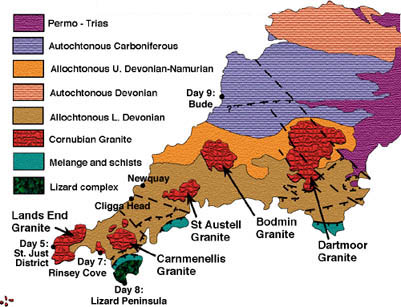
Introduction
The peninsula of Cornwall has a geological character distinct from that of the rest of the United Kingdom. It represents the eroded basement of a Palaeozoic Mountain Belt formed by the Variscan Orogeny. Although rocks affected by the same collision occur in South Wales and the Mendips region, it is only in Cornwall that we see the S-type granites so indicative of mountain building processes. This area is known geologically as the Cornubian Massif (Cornubia being the Latin name for Cornwall). Although the internal zones (i.e. those most deformed and intruded) of the Variscan Belt occur in Brittany, the Massif Central and NW Spain, Cornwall shows many features associated with mountain building processes: compressional structures, thrust faults and folds, the remnants of a closed ocean (the Lizard Ultramafic Complex), a low grade regional metamorphism (crustal thickening was not as pronounced here as it was in Brittany, etc.), and the intrusion of the aforementioned granites which produced contact metamorphic aureoles and abundant mineralisation.The granites have influenced the landscape and economy of Cornwall, providing the tin and other ore resources, and the kaolinite (china clay) deposits. The exposed granites form stocks and plutons which at depth belong to the Cornubian Batholith. The main exposed granites, from east to west are Dartmoor, Bodmin Moor, St. Austell, Carnmenellis, Tregonning-Godolphin, Land's End and the Scilly Isles. The existence and extent of the subsurface batholith has been determined geophysically.
The Cornubian Batholith
The granites were intruded towards the close of the Variscan Orogeny over a time period extending from 300 - 275 Ma (late Carboniferous - Permian). Mineralogically, they are two-mica granites, meaning they contain muscovite and biotite, plus quartz, K-feldspar and plagioclase (alkali granites). On the whole they are coarse grained and in places are pegmatitic. Distinctive are the large phenocrysts, several centimetres long, of K-feldspar, often showing Carlsbad twins clearly visible in hand specimen.
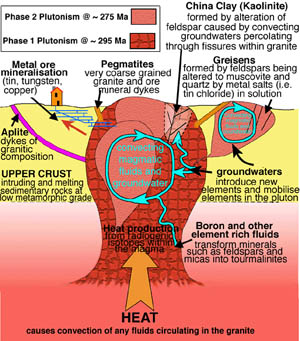 The granites are associated with very coarse-grained pegmatites, and also fine-grained granitic sheets called aplites, which typically have a mineralogy of quartz and K-feldspar.
The granites are associated with very coarse-grained pegmatites, and also fine-grained granitic sheets called aplites, which typically have a mineralogy of quartz and K-feldspar.
pegmatite - a very coarse-grained igneous rock (more than 3cm). They are late stage products of highly differentiated magmas rich in volatiles. The unusual chemical composition of the magma accelerates crystal growth which results in the large grain size
aplite - light-coloured, fine-grained igneous rock with a characteristic sugary texture. They have the same mineralogy as granite and generally form from residual magmas low in volatiles, thus promoting fineness of grain.
Both these rock types are commonly found as dykes and veins.
The granites are intruded into clastic meta-sediments of low metamorphic grade (greenschist facies) and are surrounded by well-developed contact-metamorphosed aureoles, featuring hornblende hornfels and spotted pelites (the spots are frequently andalusite).
Metasomatism associated with the Batholith
Metasomatism is a process often closely linked with the intrusion of igneous bodies and contact metamorphism. Metasomatism is the alteration of country rocks (and often the intrusion too) by circulating hydrothermal fluids. The processes and reactions are immensely complex. The resulting mineralogy is dependent on the composition of the country rocks, the composition of the intrusion and the composition of the circulating fluids, including whether or not they have mixed with groundwaters (meteoric waters).Hydrothermal fluids carry ions in solution which will replace those in pre-existing minerals, thus breaking them down and replacing them with a new mineral of metasomatic origin. The ions and compounds frequently carried in circulating fluids include CO2, Cl-, F-, metallic ions, B3+, and other elements.
The Cornish granites are well known for their metasomatic deposits, particularly the widespread occurrence of the mineral tourmaline, as well as greisens, ore mineralisation and kaolinisation. Also, the granites are rich in the pink mica lepidolite, a metasomatic addition from lithium-rich fluids.
Tourmalinisation
Tourmaline is common in all of the granites, and dominates the mineralogy in many. Such rocks are called luxullyanites after the village of Luxullyan on the St. Austell Granite. Large tourmaline crystals occur in veins and pegmatites.
The majority of the tourmalines are black in hand specimen (yellow or blue in thin section) and are of the sodic varieties schorl and elbaite. Variations in colour arise due to trace and major element variations. The red/pink variety rubellite occurs in some localities but is rare and has been overcollected.
Greisens
The zone of greisenisation is generally thin. At Cligga Head (Day 5), near Perranporth, greisens are only a few centimetres thick, bordering narrow cassiterite veins. The greisen minerals are associated with chlorite and tourmaline.
Kaolinisation
The conversion of feldspars ((K,Na)AlSi3O8) to kaolinite Al4Si4O10(OH)8 is generally associated with the processes of weathering by groundwaters. However, the large scale and the depth of the funnel shaped kaolinite bodies suggests that they were formed by processes more extensive than just surface weathering. It is, therefore, assumed that the mineralisation occurred as a result of the circulation of meteoric waters plus recharge from hydrothermal solutions derived from the granites.
Ideally, an ophiolite should have a sequence, from bottom to top, comprising peridotite and pyroxenites overlain by gabbros, a swarm of "sheeted dykes" and finally pillow lavas and cherts representing the ancient seafloor.
Generally when an ophiolite is emplaced they are tilted over and dissected and so all these components may not be present. Such slivers of ophiolite may show overprinting effects as a result of regional metamorphism or may still retain the characteristics of sea-floor metamorphism. More often than not (and this is certainly the case with the Lizard Complex) the bulk of the preserved material are peridotites and these are generally serpentinised. The Lizard Complex contains a sequence of rocks including partially serpentinised peridotites, gabbros and metamorphosed basalts and basaltic dykes.
Sea-floor metamorphism
Serpentinisation
Serpentinisation produces clay minerals of the serpentine family (lizardite, antigorite and chrysotile), and hydrous minerals such as chlorite, tremolite and talc. These are all derived from the breaking down of the ferromagnesian minerals, olivine and pyroxene. Iron from these minerals is resurrected in the form of Fe-rich clays like smectite and goethite, and oxides such as haematite.
The textures of serpentinites are variable. At simplest, they show a replacement of undeformed olivines from the grain boundaries and fractures inwards. This results in a rock with a networked appearance resembling (vaguely) snake skin from whence the name comes. More often than not they are deformed and exhibit a foliation. Serpentinites are frequently criss-crossed by veins filled with fibrous serpentine and tremolite. These are often pale green in colour (in which case the mineral is the serpentine antigorite).
The softness, and ability to take a good polish has made serpentinite an ideal material for carving model lighthouses from. These can be purchased at great expense from a number of shops in western Cornwall, and they do in fact show up the textures and variations within the rock admirably.
he deformation, whilst complex, is generally less complex than that of the Caledonide Orogeny, with a single fold phase providing the dominant structural style. The intrusion of granites occurred towards the end of the Variscan events. Cooling and alteration of the granites and their country rock and the associated mineralisation continued for a very considerable time after emplacement of the granites.
Finally it is important to note that the Carboniferous and Devonian rocks of north Devon and Cornwall are greywackes and slates. Originally these sediments were deposited on a steep slope where substantial sedimentary thicknesses could accumulate. This is in marked contrast to the Devonian and Carboniferous of the Mendips and South Wales. This contrast has major palaeogeographical implications which we have to consider.
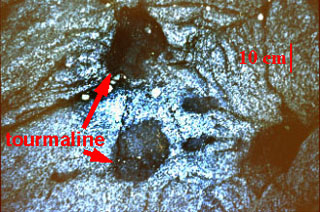 Tourmalinisation is the metasomatic replacement of feldspars and micas by the mineral tourmaline. The reaction is complex but involves the circulation of hydrothermal fluids rich in both the elements boron and fluorine. This process is widespread in the Cornish granites, and if allowed to go to completion will form a rock of granite origin where all the feldspars and micas have been replaced, forming a rock containing quartz and tourmaline only.
Tourmalinisation is the metasomatic replacement of feldspars and micas by the mineral tourmaline. The reaction is complex but involves the circulation of hydrothermal fluids rich in both the elements boron and fluorine. This process is widespread in the Cornish granites, and if allowed to go to completion will form a rock of granite origin where all the feldspars and micas have been replaced, forming a rock containing quartz and tourmaline only.
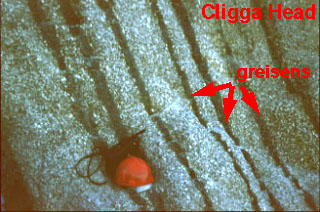 Greisens are a rock composed of quartz and muscovite mica formed by the breakdown of feldspars by metasomatic and hydrothermal activity. Greisens are commonly associated with tin - tungsten mineralised veins; i.e. the ore minerals cassiterite and wolframite respectively.
Greisens are a rock composed of quartz and muscovite mica formed by the breakdown of feldspars by metasomatic and hydrothermal activity. Greisens are commonly associated with tin - tungsten mineralised veins; i.e. the ore minerals cassiterite and wolframite respectively.
The reactions involved are:
SnCl2 + 3(K,Na)AlSi3O8 + 2H2O ->
SnO2 + KAl3Si3O10(OH)2 + 6SiO2 + 2NaCl + H2
tin chloride + feldspar + water -> cassiterite + muscovite + quartz + halite + hydrogen
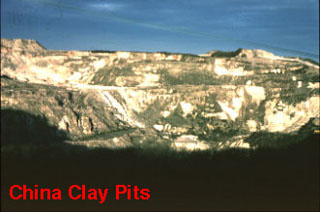 The breaking down of feldspars to the clay mineral kaolinite by metasomatic and/or meteoric fluids. The china clays (Day 6) of the Cornish granites are by far the most economically valuable material to be extracted from the region. They occur in funnel - shaped bodies developed to a greater or lesser degree in all the granitic bodies, but are at their best in the St. Austell granite where they have been extensively worked.
The breaking down of feldspars to the clay mineral kaolinite by metasomatic and/or meteoric fluids. The china clays (Day 6) of the Cornish granites are by far the most economically valuable material to be extracted from the region. They occur in funnel - shaped bodies developed to a greater or lesser degree in all the granitic bodies, but are at their best in the St. Austell granite where they have been extensively worked. 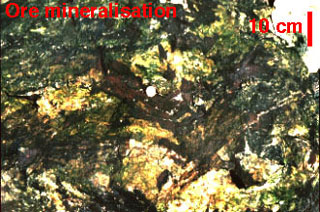 Ore Mineralisation
Ore Mineralisation
The deposition of metallic elements carried in hydrothermal fluids to form ore deposits. Two types of mineralisation are important in Cornwall:
tin-tungsten mineralisation, associated with greisens, and
copper-lead-zinc-iron-arsenic mineralisation.
The Lizard Complex
Ultramafic igneous rock bodies, in the form of ophiolites are a common feature of orogenic belts, representing suture zones formed as oceanic basins close. An ophiolite is a sliver of oceanic crust that has been overthrust onto continental crust during continent-continent collision. Ophiolites rarely sit on the sutures and are usually transported some distance away from it along thrust faults, and such is the case with the Lizard Complex of western Cornwall (Lizard Peninsula - Day 8).
Sea-floor metamorphism is hydrothermally driven, and therefore, at least in part, metasomatic. The rock types that represent the ocean floor, namely pillow basalts and basalt sheet flows (which are very poorly preserved in the Lizard Complex) tend to have been altered to spilites, where the calcic-plagioclases have altered to sodic-plagioclase as a result of ion exchange with salts in seawater. Commonly, these rocks also develop a greenschist assemblage of new minerals, particularly chlorite and epidote.
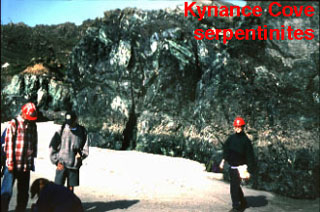 Ultramafic rocks are prone to low temperature alteration and metamorphism. The reason for this is that the minerals that comprise ultramafic rocks are more at home in the mantle, and therefore residence in the upper crust removes them far away from their stability fields. Also, in the mantle there is very little, water, whereas water is abundant in the upper crust and such minerals, namely olivines and pyroxenes, are unstable in the presence of water. Therefore, we are presented with the somewhat unusual case whereby metamorphism is induced in mantle rocks by a decrease in temperatures and pressures rather than an increase!
Ultramafic rocks are prone to low temperature alteration and metamorphism. The reason for this is that the minerals that comprise ultramafic rocks are more at home in the mantle, and therefore residence in the upper crust removes them far away from their stability fields. Also, in the mantle there is very little, water, whereas water is abundant in the upper crust and such minerals, namely olivines and pyroxenes, are unstable in the presence of water. Therefore, we are presented with the somewhat unusual case whereby metamorphism is induced in mantle rocks by a decrease in temperatures and pressures rather than an increase!
Phenocrysts of orthopyroxenes may be pseudomorphed (replaced by another mineral whilst retaining habit and possibly internal features) by a complex mixture of talc and tremolite. This mix is given the name bastite, and the porphyroblasts generally show up well, with a pale green colour in the otherwise homogenous serpentinite groundmass, giving strikingly porphyroblastic serpentinites.
Sediments and structure
Cornwall and much of Devon consists of a series of argillaceous and arenaceous sediments that have now been ubiquitously subject to low grade regional metamorphism and which, over extensive areas, have also experienced high grade contact metamorphism, metasomatism and mineralisation associated with intrusion of a major granite batholith. The majority of the meta-sediments are pelites or greywackes and are of Devonian age, although in North Devon a large synclinal structure preserves Carboniferous sediments of similar facies.
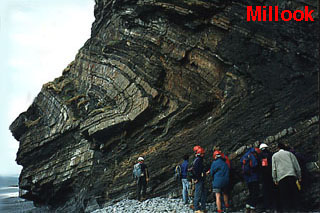 All of these rocks were subject to intense deformation during the late Carboniferous to early Permian Variscan Orogeny and the coastal sections (particularly in the vicinity of Bude (Day 9) provide many of the classical examples of fold and thrust geometry that are seen in structural geology textbooks.
All of these rocks were subject to intense deformation during the late Carboniferous to early Permian Variscan Orogeny and the coastal sections (particularly in the vicinity of Bude (Day 9) provide many of the classical examples of fold and thrust geometry that are seen in structural geology textbooks.